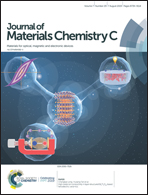Modularization design philosophy for multifunctional materials: a case study of a Janus film affording concurrent electrically conductive anisotropic-magnetic-fluorescent multifunctionality†
Abstract
Inspired by the unique structure of Rubik's Cube, which consists of miniature cubes, herein, a new concept, namely “modularization design”, of designing multifunctional materials as well as its implementation method are proposed. For illustrating this novel design philosophy, herein, a multifunctional 4-module electrically conductive anisotropic-magnetic-fluorescent Janus film (named as 4M-EMF Janus film) composed of a tightly combined fluorescence module (denoted as the F module), magnetism-fluorescence module (expressed as the M-F module), adjustable fluorescence module (defined as the AF module), and electricity-fluorescence module (marked as the E-F module) was fabricated. The morphologies, structures and properties of the color-tuned fluorescence, adjustable magnetism and variable anisotropic conduction of the different modules of the 4M-EMF Janus film were systematically studied. The results prove that almost no detrimental mutual influences exist among the different functional modules owing to the macroscopic partition of the 4M-EMF Janus film originating from the modularization design philosophy, which effectively avoids negative interactions among different functional modules and enhances the comprehensive performance of the 4M-EMF Janus film. Moreover, microcosmic partition philosophy was incorporated to design and fabricate the modules. For instance, Janus nanobelts with two microcosmic partitions were designed and used to fabricate the E-F module to ensure a high degree of conductive anisotropy and strong fluorescence. In addition, the 4M-EMF Janus film achieved synchronous conductive anisotropy, magnetism and tri-colored fluorescence at one layer and red fluorescence at the other layer. The novel modularization design philosophy provides a flexible design and fabrication strategy to obtain high-performance multifunctional materials. More importantly, the modular design philosophy and the new nanomaterials derived from this philosophy will have important applications in many fields in the future.



 Please wait while we load your content...
Please wait while we load your content...